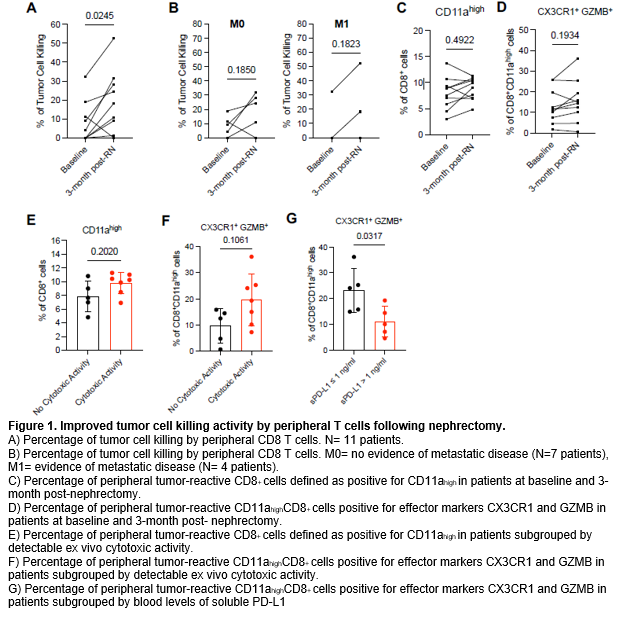Back
Introduction: Renal cell carcinoma (RCC) elicits immune dysfunction through infiltration of immunosuppressive cells and expression of immuno-inhibitory molecules such as PD-L1. The impact of removing primary malignancy on boosting systemic antitumor immunity remains unclear. Here, we investigated the impact of nephrectomy on cytotoxic activity of patient-driven CD8 T cells.
Methods: Peripheral blood mononuclear cells (PBMC) were isolated from 11 prospectively enrolled patients before and at 3-month post nephrectomy for clear cell RCC. Human 786-O ccRCC cells was used as target cells and killing rates were measured by calcein release assay. Wilcoxon paired t test and Mann Whitney test were used for analysis.
Results: Five patients showed detectable patient-derived CD8 T cells killing at baseline and this number increased to 7 at 3 months. Four patients showed no T-cell killing at both baseline and 3 months. The killing rate was 1.9 higher at 3-month compared to baseline, 21.4% (range 0%-52.5%) versus 11.4% (range 4.0% to 32.5%), respectively (p=0.0245). Level of tumor-reactive CD11ahighCD8 T cells at 3 months was increased in 7 patients compared to baseline while 2 patients showed decreased and another 2 had unchanged levels. For T cells positive for CX3CR1 and GZMB, 6 patients showed increased levels at 3 months, 2 decreased and 3 had unchanged levels. At 3 months, patients that had T cell cytotoxic activity had higher levels of CD11a (mean 10.27% vs 7.7%, p=0.20) and CX3CR1 and GZMB (mean 9.62% vs 19.6%, p=0.11), two marker of enhanced cytotoxicity. There were lower levels of tumor-reactive effector CD8 T cells in patients with blood concentrations of PD-L1 > 1 ng/ml compared to patients with = 1 ng/ml (mean 6.146 ng/ml vs 0.121 ng/ml; p=0.032) (Figure 1).
Conclusions: Nephrectomy is associated with an increase rate and enhanced tumor cell killing ability of peripheral CD8 T cells. Higher levels of CD11a, CX3CR1 and GZMB CD8 T cells as well as lower PD-L1 serum levels after surgery were associated with higher cytotoxic activity of patient-derived tumor-reactive effector CD8 T cells. SOURCE OF
Funding: This work was supported by NIH R01CA256927 and R01AI095239.

Moderated Poster Session
Session: MP04: Kidney Cancer: Basic Research & Pathophysiology I
MP04-19: Impact of Surgery on Cytotoxic Activity of Patient-driven CD8 T cell
Friday, April 28, 2023
7:00 AM – 9:00 AM CST
Location: S405

Reza Nabavizadeh, MD (he/him/his)
Mayo Clinic Rochester, Minnesota
Poster Presenter(s)
Introduction: Renal cell carcinoma (RCC) elicits immune dysfunction through infiltration of immunosuppressive cells and expression of immuno-inhibitory molecules such as PD-L1. The impact of removing primary malignancy on boosting systemic antitumor immunity remains unclear. Here, we investigated the impact of nephrectomy on cytotoxic activity of patient-driven CD8 T cells.
Methods: Peripheral blood mononuclear cells (PBMC) were isolated from 11 prospectively enrolled patients before and at 3-month post nephrectomy for clear cell RCC. Human 786-O ccRCC cells was used as target cells and killing rates were measured by calcein release assay. Wilcoxon paired t test and Mann Whitney test were used for analysis.
Results: Five patients showed detectable patient-derived CD8 T cells killing at baseline and this number increased to 7 at 3 months. Four patients showed no T-cell killing at both baseline and 3 months. The killing rate was 1.9 higher at 3-month compared to baseline, 21.4% (range 0%-52.5%) versus 11.4% (range 4.0% to 32.5%), respectively (p=0.0245). Level of tumor-reactive CD11ahighCD8 T cells at 3 months was increased in 7 patients compared to baseline while 2 patients showed decreased and another 2 had unchanged levels. For T cells positive for CX3CR1 and GZMB, 6 patients showed increased levels at 3 months, 2 decreased and 3 had unchanged levels. At 3 months, patients that had T cell cytotoxic activity had higher levels of CD11a (mean 10.27% vs 7.7%, p=0.20) and CX3CR1 and GZMB (mean 9.62% vs 19.6%, p=0.11), two marker of enhanced cytotoxicity. There were lower levels of tumor-reactive effector CD8 T cells in patients with blood concentrations of PD-L1 > 1 ng/ml compared to patients with = 1 ng/ml (mean 6.146 ng/ml vs 0.121 ng/ml; p=0.032) (Figure 1).
Conclusions: Nephrectomy is associated with an increase rate and enhanced tumor cell killing ability of peripheral CD8 T cells. Higher levels of CD11a, CX3CR1 and GZMB CD8 T cells as well as lower PD-L1 serum levels after surgery were associated with higher cytotoxic activity of patient-derived tumor-reactive effector CD8 T cells. SOURCE OF
Funding: This work was supported by NIH R01CA256927 and R01AI095239.

